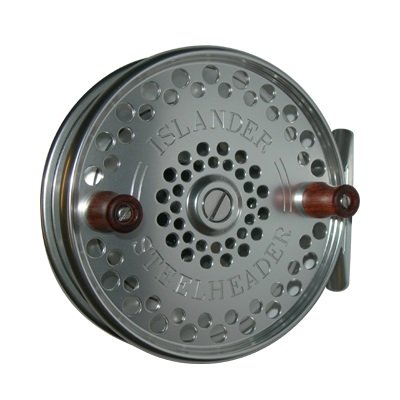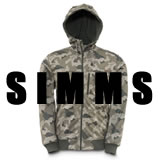 |
| Angler's and the reward of pinning! |
“Path to the Pin: Part Two”
By Todd Harris - May 10, 2012
To Read Part One Scroll Down.
Casting a center pin reel is unique and somewhat challenging. I recommend checking out some videos and putting in some practice.
However, you can be successful without being a proficient caster. If you fish
from a boat, then you may want to try the following technique whenever the
water conditions allow.
Most of the time when I am guiding
centerpin anglers, I will hold the boat IN the water I want them to fish,
either by sitting on anchor, or working the oars, similar to plugging. Then,
all that is required of the angler is to simply drop the offering in the water
off the front of the boat, and let the current take the float downstream. The
beauty of this technique is that there is no need to mend as you are fishing
in-line with your float. Any necessary line management will be very minimal.
This makes a huge impact on the quality of drift you can accomplish because
your float is rarely disturbed due to mending and/or drag. The other nice thing
about fishing this way is that you eliminate conflicting currents that may
interfere with your drift. When your float gets to the end of the drift, reel
up and drop it again. If you are working big water, simply change the lane you
run each drift and you can effectively cover all the water. Again, this
“in-line” method of pinning only works for certain water types that allow you
to set up in-line with the water you want to fish.
Many pieces of water are going to be
smaller, more defined, too fast, or for some other reason unfishable with an
in-line presentation. In these scenarios, I will anchor up as close as I can to
the holding water, again trying to avoid mending, drag, and conflicting
currents. I always try to avoid long casts if I can. This just means more line
on the water causing me trouble.
Water clarity also plays a huge role
in how I fish. Obviously if you are fishing low, clear water, you would not
want to anchor too close to the holding water. Centerpins really shine in low
water due to the long drag-free drifts that you can get. I like to set up way
above where I think fish will be and run really long drifts to avoid spooking
fish with the boat.
Many times steelheading success is
more about HOW you fish than WHAT you fish. “When steelhead are in the mood they
will eat your car keys!” This quote came from one of the great pioneers of
steelheading in the Northwest and rings in my head all the time. The discussion
that followed was about how much more important all the other factors were and
fly choice was more about your confidence. Many steelheaders get caught up in
what they are fishing and fail to pay closer attention to how they are fishing.
Again, the key to the success of the centerpin is in the ultimate presentation.
In part one I talked about how critical
it is to get a dead drift. However, there are times when fish prefer a little
more action. When fishing jig heads have you ever noticed that when dead
drifted, the jig head is in front of the worm or jig feathers? Next time you’re
on the river, drop your jig in the water and watch as it drifts, and you will
notice that the heavy head will lead your worm or hair downstream. Something I
have played with is putting very slight pressure on the spool as line is paying
out, just enough to tilt your float back a little, and slow your drift
slightly. What happens is your jig head will be held back just enough to allow
your worm or feathers to “swim”. This idea came from my time swinging flies.
When swinging, you want to get your fly under tension as soon as possible to
impart that deadly swimming action. A dead drifted fly does not have near the
action of a fly under tension. I think the same principle applies to jigs to a
certain extent. I began to notice that a lot of my better pieces of jig water
always had some amount of surface chop. This chop creates vital action on the
jig. So, I started holding back my drift a little in water with little or no
surface chop to create my own swimming action and found some good results. This
can get tricky so another great option is to switch terminal gear for different
water types. Typically whenever I have good surface chop, I will go with a pink
worm or marabou/bunny jig. When I encounter relatively calm or slick-surface
water, I will switch to a bead. I mentioned bead fishing in part one and highly
recommend trying one in this type of water. Beads are meant to tumble naturally
and fish really well in calmer water.
“Path to the Pin: Part 1”
by Todd Harris - April 27,2012
Memories
are funny, especially when it comes to steelhead. I have a hard time
remembering many simple day-to-day things in life, but when asked about a
fishing trip, whether it was recent or many years back, I am able to recount
every fish, how, and where they were caught, and what the water conditions were
like. My path to centerpin fishing for steelhead goes like this.
When I was six, I landed my first
steelhead on a plug with my father on the oars; I remember that day well. I am
now 35 and have been obsessed with steelhead ever since. I have gone through a
progression of sorts in my steelhead pursuits. After landing my first fish on
that plug, I wanted more! More became my goal on every outing for many, many
years. When I would float a river, I had plug rods, drift fishing rods, and
later bobber rods. I would fish each piece of water with the most productive
technique. I had finely tuned plugs, good bait, hand tied jigs…The list goes
on.
When I was a junior in high school, I
asked for a fly rod for Christmas and my love affair with fly fishing began. My
days of plugging, side drifting, diver and baiting, drift fishing, and bobber
fishing with spinning gear were over. I sought out everything I could on fly
fishing and eventually had my first “tug” on the swing and, to say the least, I
was exhilarated. I found out how effortless two-handed rods were for delivering
the fly, and soon all you could find in my boat was a quiver of two-handed rods
rigged for swinging. I did nothing but swing for years. The days of big numbers
were gone, but one on the swing was plenty.
One afternoon after swinging a run
with a good friend of mine, we were sitting on his tailgate and he mentioned
that he was looking to sell his centerpin gear. At this point, I had never even
laid eyes on this stuff. He pulled out this long soft rod with a funny looking
reel latched on by a couple of sketchy looking rings. He showed me the set up
and explained that it is a deadly way to fish “floats”. Thus began the next
phase in my pursuit of steelhead.
Catching steelhead on a swung fly is
an amazing feeling, and I believe something every steelheader should at least
try in his or her lifetime. I still love to swing, but I was always mindful
that I was passing up a lot of greedy water that could not be fished with a
fly. As I learned the deadly potential of a centerpin, I started swinging the
good swing water and pinning the rest. This is where I am today and I love the
traditional approach and the one- on-one fight you get with a centerpin reel.
So, I would like to share some of what I have learned since that day many years
ago when I first touched a centerpin reel in hopes that others might pick up on
this challenging, yet highly effective, method of fishing.
I still get funny looks on the water
here in the Northwest, as many anglers have never seen a centerpin reel in
action. My fishing buddy who passed along his gear to me is from the Midwest
where steelheaders have been pinning for a LONG time, and the tradition runs
VERY deep with centerpins. The question I
get most often from my friends and clients is why use centerpin gear when you
can fish floats with any type of rod and reel. My response is that you can
accomplish the ultimate drift and maintain commanding control, it’s challenging,
and it’s really fun to fight fish on. I float fished for years with spinning
and level wind reels and I can tell you that you will LOVE the line control and
the long unencumbered drifts you can get with a centerpin set up.
Getting started with a new technique
is tough from a financial standpoint, and you have to be patient with the
learning curve. As with everything fishing, one can spend a lot of money on
gear or go cheap. Find what fits your budget and what you are comfortable
spending. If you have the means, I would say put your money into the reel. I
own Islanders and Ross. As for rods, my first was a St. Croix and no matter how
hard I tried to break that thing, it just kept fishing. Now I own Loomis rods
and they are incredibly light and sensitive. My favorite length is in the 11’3”-13’
range. They come in longer lengths but I haven’t seen the merit in the waters I
fish. Load the reel with backing and top it with a highvis floating mono, like
Raven mainline, and you are on your way.
Next comes how to rig this type of
setup. To avoid the inevitable line twist that comes with most techniques of
centerpin casting, you will want to tie a micro swivel to your main line. I use
Raven 4X-small as they seem to pass through the guides relatively well, and I
have yet to have one fail even on the occasional Chinook that decides to grab a
steelhead offering. Next, the most simple rigging involves about 8ft of low vis
mono or fluorocarbon. My mainline is 12lb so I use 12lb for this first section
of my leader. The next piece is your float. The vast majority of the time a
fixed float will do the job. If you encounter a piece of water that is really
deep, you may need a slip float, which is a whole different set up. For this
article I will focus on a fixed float rigging. Raven makes a variety of floats that
will fit any water type you may encounter and they attach to your line with
silicone tubing. One thing I have found is the 3/32” diameter tubing works best
for the bottom AND top of the float. The smaller diameter on top tends to
reduce float slippage when setting the hook. Having the float attached by only
the tubing allows for quickly changing floats when needed.
Once the float is attached, tie on
another micro swivel and about 3ft of 6-10lb tippet. Just remember that you do
not want your total leader length longer than your rod. With this set up you
should break off at the bottom swivel and save your float should you find a
snag.
The final piece is what to fish as
your offering. My first steelhead on a centerpin fell for a 3 inch pink worm on
a ¼ ounce jig head under a FM 6.2 gram Raven float. To this day, that is one of
my go-to offerings for winter steelhead. I like to keep things relatively
simple, and it does not get much easier than a pink worm or hair jig under a
float. One KEY is matching your float to the amount of weight you are fishing.
You want your float to ride straight up and down when dead drifted and the
color change should be right at the water line. I primarily fish two floats,
again keeping things simple. The fast medium (FM) floats from Raven have a nice
taper for most steelhead water with the 6.2g supporting a ¼ ounce jig head
nicely and the 5.0g float supporting a 1/8 ounce jig head. I could go on
forever about the subtleties of balancing a float, but this will get you in the
game.
The other method I use quite often is
a single trout bead pegged 2 inches from the hook. I have guided in Alaska for
12 years on the upper Kenai and have taken the bead form AK trout to Northwest
steelhead and found amazing results. Fishing a bead requires distributing the
weight down your leader, creating a “shot pattern”. This pattern of shot will
help balance your float and correctly present the bead. Shot pattering can get
very technical and I recommend doing some research. I learned by trial and
error but as a general rule, I run 3-4 bb shot on the bottom swivel and spread
shot out in 1-2ft increments until my float rides properly. Raven makes a
variety of shot that will suit shotting for Northwest steelhead. Bead fishing
for steelhead is catching fire, and fishing one under a float with a centerpin
is a must for the bag of tricks.
When presenting a jig, or bead, or any
thing for that matter with a centerpin, you want as close to a dead drift as
possible and this is easily attained with a centerpin. Set your depth to within
a foot of the bottom and cast your offering into likely water and let it run
drag free. Adjust your depth until you touch bottom then come up just a bit to
put your offering in the zone. Constantly adjusting your depth for each new
piece of water is critical.
A drag free drift is the key to this
technique, and the high-visibility floating monofilament will help you achieve
a perfect drift. The concept of mending is known to fly fisherman and applies
to float fishing as well. If you begin to develop a downstream belly in your
line, lift your rod and manipulate your line to eliminate the belly. When
mending, try not to disturb your float as it glides through the drift. LONG
drifts are possible with a pin, but only allow your float to run as long as you
can detect a strike. With the long rods used in centerpinning, you can set the
hook at the end of an extended drift, just but be sure to swing big and reel
until you feel the fish.
If
all goes well and you end up tied into some chrome, then you will experience
the give-and-take battle of fighting a fish on a centerpin. With zero drag you
must finger or palm the rim of the reel during the fight. This takes some
getting used to and is a lot of fun. The finesse involved makes landing a fish
a bit more of a challenge than with other types of reels. In my next segment I
will talk more on the finer points of how to fish a centerpin effectively.
Come back next week for part two of "Path to the Pin"...






.jpg)





No comments:
Post a Comment